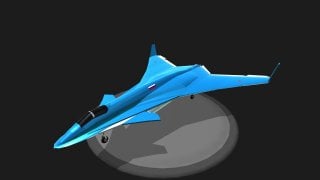Russia's T-60S has Been Bested
The Sukhoi T-60S project grew out of the older T-4 concept, a proposed Soviet reply to the XB-70 Valkyrie that never made it past the prototype stage.
Here's What You Need to Remember: In the end, the T-60S’ well-rounded performance and robust combat capabilities were not worth the risks stemming from its more eccentric construction choices. The Kremlin decided, not without sound reason, that the Su-34 fighter-bomber was a safer bet. The Su-34 has gone on to become a staple of Russia’s strike fighter forces, with as many as 120 models currently in service and several waves of modernization packages planned in coming years.
One of the Soviet Union’s most ambitious postwar aircraft projects, the ill-fated T-60S bomber, offers a glimpse of the modern Russian bomber force that could have been.
In the mid-1980s, the Soviet military launched a procurement search for a new intermediate-range bomber to phase out its slew of aging aircraft. The early 1970’s Su-24 attack aircraft and Tu-22M strategic bomber were most in need of a replacement, but Soviet authorities were also interested in laying long-term plans for a versatile, modernized bomber platform to succeed the newer Tu-22M3.
The Sukhoi T-60S project grew out of the older T-4 concept, a proposed Soviet reply to the XB-70 Valkyrie that never made it past the prototype stage. The T-60S project was shrouded in secrecy since its inception, and many of the details surrounding its rocky development remain classified to this day. Still, it is widely believed that the T-60S is a variable geometry swing aircraft, equipped with two-dimensional thrust vectoring nozzles. The latter change is meant to mitigate control instability at high speeds, one of the chief problems confronting the prior T-4MS program. Capable of supercruising at Mach 2 and boasting a takeoff weight of roughly ninety tons, the T-60S is significantly lighter and marginally faster than the Tu-22M3. There were reports that the T-60S was to utilize new stealth features for enhanced deep penetration capabilities, though the precise nature of these efforts remains unclear.
Boasting a combat range of 2,200 km, the T-60S was believed to carry a payload of up to 20,000 kg. The bomber’s armaments included cruise missiles from the Kh-101 and Kh-55/65 series, a large catalog of guided munitions, and conventional as well as nuclear unguided bombs—this makes the T-60S similar to the Tu-22M3 in armament configuration, albeit the latter boasts a noticeably larger payload of 24,000 kg.
A T-60S prototype was slated to undergo flight tests in 1996, with the bomber scheduled to enter service in 2003. The collapse of the Soviet Union put a swift end to these plans, with the project facing outright cancellation in the early 1990s. Still, there were some signs to suggest that the T-60S project was headed for technical disaster irrespective of the Soviet collapse. Sukhoi engineers apparently struggled to implement some of the T-60S’ unique design decisions, including controversial changes made to the wing construction.
In the end, the T-60S’ well-rounded performance and robust combat capabilities were not worth the risks stemming from its more eccentric construction choices. The Kremlin decided, not without sound reason, that the Su-34 fighter-bomber was a safer bet. The Su-34 has gone on to become a staple of Russia’s strike fighter forces, with as many as 120 models currently in service and several waves of modernization packages planned in coming years. Likewise, the upcoming Tu-22M3M—one of the handful of Russian aircraft confirmed to be compatible with the new, nuclear-capable Mach 10-speed Kh-47 “Kinzhal” missile—is slated to enter service this year.
Mark Episkopos is a national security reporter for The National Interest. This article first appeared earlier this year.
Image: Wikimedia Commons.

